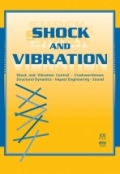Authors: Bellino, A. | Marchesiello, S. | Garibaldi, L.
Article Type:
Research Article
Abstract:
It is well known that nonlinear systems, as well as linear time-varying systems, are characterized by non-stationary response signals. In this sense, they both show natural frequencies that are not constant over time; this variation has however different origins: for a time-varying system the mass, and possibly the stiffness distributions, are changing over time, while for a nonlinear system the natural frequencies are amplitude-dependent. An interesting case of time-varying system occurs when analyzing the transit of
…a train over a railway bridge, easily simulated by the crossing of a moving load over a beam. In this case, the presence of a nonlinearity in the beam behaviour can cause a significant alteration of the modal parameters extracted from the linearized model, such that the contributions of the two effects are no more distinguishable. For this study, some reinforced concrete beams have been tested in the framework of a vast project: these beams show a clear softening nonlinear behaviour, well detectable when the excitation is produced by a hammer (free response). If the passage of a carriage is considered, moreover, the variation of natural frequencies is always larger than expected because of this softening nonlinearity. The article first analyzes theoretically the two effects on the natural frequencies of a simply supported beam, then a numerical and an experimental tests are presented. The identification procedure is conducted with a linear algorithm called ST-SSI, which has been demonstrated to be appropriate for the analysis of non-stationary signals, in particular in presence of moving masses. The article shows that the nonlinear contribution can be well estimated by using this linear tool but, on the contrary, when also moving masses are present, it is difficult to separate the nonlinear effects from the time varying ones.
Show more
Keywords: Moving load, nonlinear behaviour, Short Time Stochastic Subspace Identification, concrete reinforced beams
DOI: 10.3233/SAV-2012-0704
Citation: Shock and Vibration,
vol. 19, no. 5, pp. 969-978, 2012
Price: EUR 27.50





